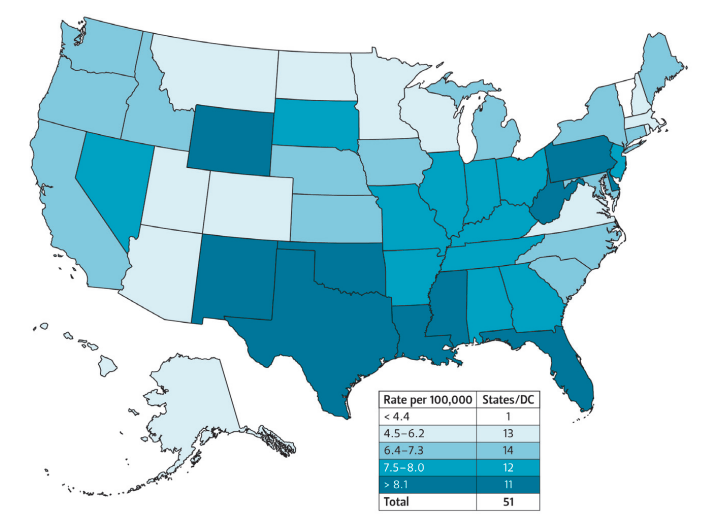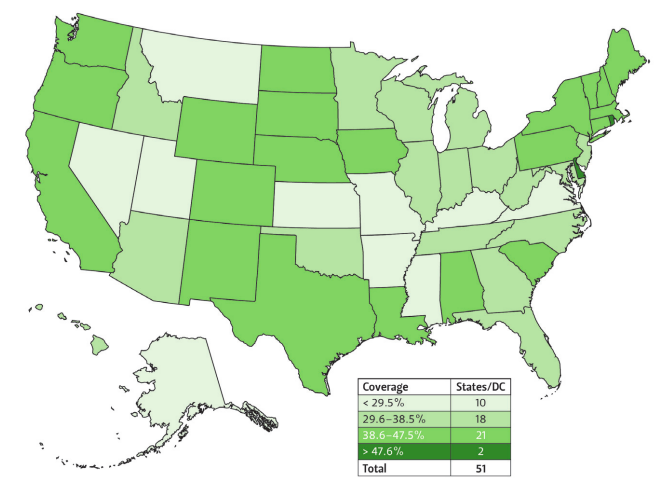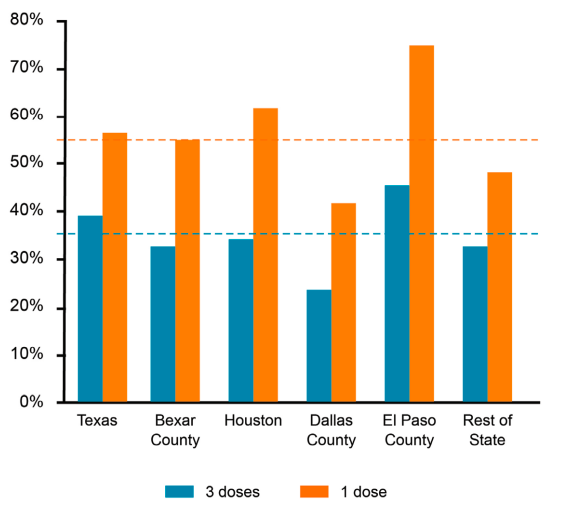Human Papillomavirus Vaccine: A Public Health Opportunity for Texas

Table of Contents
Author(s)
Kirstin R.W. Matthews
Fellow in Science and Technology PolicyMonica M. Matsumoto
Former Contributing ExpertShare this Publication
- Download PDF
- Print This Publication
- Cite This Publication Copy Citation
Matthews, Kirstin R.W. and Monica M. Matsumoto. 2014. Human Papillomavirus Vaccine: A Public Health Opportunity for Texas. Policy Brief no. 10.06.14. Rice University’s Baker Institute for Public Policy, Houston, Texas.
Tags
Abstract
In the United States, human papillomavirus (HPV) infections affect more than 79 million men and women and account for more than 4,000 deaths from cervical cancer each year (Markowitz et al. 2014). Globally, an estimated 530,000 new cases of cervical cancer— almost always caused by HPV—are diagnosed annually. In 2006, the US Food and Drug Administration (FDA) licensed the first HPV vaccine to prevent the spread of four prevalent forms of the virus associated with cervical cancers and genital warts. These vaccines hold the potential to save thousands of lives, especially as no cure currently exists. However, the political controversy that has erupted regarding the HPV vaccine has limited its acceptance and use among the public. This issue potentially jeopardizes an opportunity to reduce cancer rates in Texas and the broader United States.
HPV: Biology, Infection, Testing, and Treatment
The HPV family consists of more than 150 related viruses (Markowitz et al. 2014). The virus infects epithelial cells (lining the surfaces of the body) and remains isolated at the original infection site without migrating into the bloodstream. Upon introduction, HPV causes the epithelial cells to grow quickly and uncontrollably. In most cases HPV is not life threatening. Ninety percent of HPV infections disappear within two years, and the body is usually able to respond and clear the infection without medical intervention. However, if the immune system is unable to eliminate the infected cells, viral activity may persist to form lesions and eventually tumors, which in some cases can become cancerous. The period between initial HPV infection and tumor formation may be several decades.
With approximately 40 different HPV types that are spread through direct skin-to-skin sexual contact, HPVs are the most prevalent sexually transmitted infections (STI) in the United States (Markowitz et al. 2014). HPV is so common that the majority of sexually active men and women in the United States will become infected at some point in their lifetime.
There are two categories of sexually transmitted HPV infections: low and high risk. Two low-risk, non-cancerous HPVs—types 6 and 11—in particular cause nearly 90 percent of all genital warts. The high-risk, oncogenic HPV types cause lesions that can lead to tumor formation and cancer. From 2006 to 2010, approximately 33,000 cancers diagnosed in the United States were associated with HPV infections, including 10,400 cervical cancers (Markowitz et al. 2014). Specifically, two high-risk HPVs—types 16 and 18—alone are linked to 70 percent of cervical cancers; 85 percent of anal cancers; and roughly half of vaginal, vulvar, and penile cancers. Oropharyngeal cancer—which affects the back of the tongue, tonsils, and middle of the throat—is on the rise, and more than two-thirds of the cases have been linked to HPV-16 (Chaturvedi et al. 2011). In fact, while an effective screening program (routine Pap testing) accounts for the declining number of cervical cancers diagnosed annually in the United States, the number of new cases of oropharyngeal and anal cancers, for which there is no effective screening, is rising (Markowitz et al. 2014). With this continuing trend, by 2020 the incidence of HPV-associated oropharyngeal cancer will surpass that of cervical cancer in the United States (Chaturvedi et al. 2011).
The most common HPV test detects high-risk HPV types, but no test covers all forms of the virus (Markowitz et al. 2014). In addition, the FDA has only approved these tests for women either as a followup to abnormal Pap smear results or in combination with a Pap smear for cervical cancer screening over age 30. No HPV detection tests have been approved for men.
There is no cure for an HPV infection. However, many symptoms, including warts and precancerous lesions, can be treated with drugs, cryosurgery, electrosurgery, and laser surgery among other options. Treatment for cancer patients with or without HPV infections is generally the same.
HPV Prevention and Vaccination
Prior to the vaccine, the only way to prevent HPV infections was to avoid all skin-to-skin sexual contact. Because HPV status tests that cover all forms of HPV do not exist, and because symptoms may not ever manifest, any sort of sexual activity risks HPV transmission. Condoms decrease the likelihood of HPV infection, but areas not covered by a condom can be infected.
Two vaccines, Cervarix and Gardasil, were developed to prevent the HPV infections most commonly associated with genital warts and cancer (Markowitz et al. 2014). Gardasil, a vaccine created by Merck & Company and approved by the FDA in 2006, provides protection against four HPV types: 6, 11, 16, and 18. These specific genotypes were targeted because of their association with cervical cancers (i.e., HPV-16 and -18) and genital warts (i.e., HPV-6 and -11). Gardasil was tested on approximately 10,000 women and found to be 90 to 100 percent effective at preventing infection from the four targeted HPV strains over three years (Markowitz et al. 2014). It has also been approved for use in males to prevent genital warts and anal cancer. In 2009, a second vaccine, Cervarix, was created by GlaxoSmithKline to protect against the two most common high-risk viruses—HPV-16 and -18—in women.
Neither vaccine contains viral DNA, so they are non-infectious and cannot cause HPV infection or cancer. Moreover, during the clinical trials and the seven years since the introduction of the HPV vaccine, no evidence has confirmed a linkage of vaccination with serious adverse reactions, including death (Markowitz et al. 2014). Over 90 percent of adverse events reported in the United States have been “non-serious,” such as temporary skin-reddening, swelling, and pain at the injection site. Anyone with a severe allergic reaction to the first dose, while extremely rare, is not recommended to finish the three-shot series. As with other vaccines given to adolescents, HPV vaccine recipients in this age group are recommended to wait for a 15-minute observation period before leaving the clinic since fainting can occur (Markowitz et al. 2014).
Because the vaccine is still relatively new, the duration of its protection is unknown. Current research indicates that vaccine efficacy for both Cervarix and Gardasil remains high for at least eight years, although follow-up data from ongoing studies on Cervarix have reported high antibody levels persisting over four years after administration (Markowitz et al. 2014). Nevertheless, even if its potency is only five to 10 years, vaccination during puberty will provide protection during the most vulnerable time frame of acquiring HPV—the first five years following initial sexual contact.
Both Gardasil and Cervarix are given in three successive shots. Following the initial injection, the remaining two doses are administered after two and six months, respectively, for Gardasil, and after one and six months, respectively, for Cervarix. Gardasil has been approved for both males and females in the 9- to 26-year-old age range. Cervarix has been approved only for females in the 10- to 25-year-old age range. Since the HPV vaccine is a preventive measure and has no effect on those already infected with HPV, it is recommended before the onset of sexual activity (Markowitz et al. 2014). The CDC’s Advisory Committee on Immunization Practices (ACIP), with an endorsement by the American College of Obstetricians and Gynecologists, recommends the routine HPV vaccine for both girls and boys aged 11 to 12 in the United States; the American Cancer Society has the same recommendations for girls but currently has no recommendations for males (CDC 2011; ACS 2013; ACOG 2014).
Given the effectiveness of HPV vaccines and Pap smear screening, health experts believe that widespread vaccinations can drastically reduce cervical cancer rates. Over 100 countries have licensed the vaccine. The United Kingdom has even achieved over 80 percent coverage through its school-based program. Several other countries, including Canada, Rwanda, Malaysia, and Germany, have also begun offering the HPV vaccination for female adolescents as part of their routine vaccinations covered by the government (Markowitz et al. 2012).
Potential Barriers to Vaccination
After the development of the HPV vaccine and its demonstrated efficacy, the US Department of Health and Human Services (DHHS) set a goal that 80 percent of females by age 15 receive the full HPV vaccine series (CDC 2014). Nevertheless, in 2013 only 57 percent of girls between the ages of 13 and 17 received the HPV vaccine, and less than 38 percent received all three doses. For boys aged 13 to 17, only 14 percent received all three doses (Elam-Evans et al. 2014). Several barriers—including access, cost, misinformation, and politics—have inhibited DHHS’s goal from being fully realized.
First, the multi-dose injection series presents a structural barrier. The vaccine doses are administered over six months, requiring the adolescent receive care on three different occasions. Especially for those with limited health care access, the logistical difficulty with getting the necessary injections on the scheduled timeline limits the percentage of fully covered patients. Improved documentation of vaccinations through electronic medical records, as well as an automated reminder system, could help improve follow-up rates and reduce the burden on health care providers.
Perhaps even more important than logistical issues are physician recommendations. Some pediatricians either do not offer the HPV vaccine due to the expense of keeping it in stock and uncertainty of receiving a full reimbursement from insurance companies, or do not recommend it to eligible patients (Ylitalo, Hedwig, and Mehta 2013). CDC director Tom Frieden stated that one of the top reasons for low uptake of the HPV vaccine is because “doctors didn’t recommend it” (CDC 2013). This phenomenon is in accordance with broader research studies showing that, in general, a physician’s recommendation to vaccinate is the “single most influential factor” in determining whether parents get their children vaccinated (Ylitalo, Hedwig, and Mehta 2013). Specifically, female adolescents whose health care provider recommends the HPV vaccine are five times more likely to receive it than adolescents who did not receive the recommendation.
Cost is also a major barrier. The vaccine is priced at $130-300 per dose, depending on where it is administered. The recommended three-injection routine could cost up to $900. Unlike a simple flu shot, the vaccine requires a doctor’s prescription and visit, which increases the overall financial and logistical requirements. However, due to ACIP’s recommendations, health insurance must cover the three-shot series. In an effort to reduce impediments to access, Merck and GlaxoSmithKline offer assistance programs, such as free or discounted HPV shots for patients with qualifying financial needs. Federal programs—including the Vaccines for Children Program, Medicaid, and the Immunization Grant Program—cover ACIP-recommended vaccines for qualifying youth (KFF 2014). The prevalence of HPVs and the successes of the vaccination in preventing the targeted HPV types—reaching 100 percent in some cases—strongly support vaccination of adolescent girls. Cost effectiveness studies of HPV vaccination for young girls demonstrate a relatively low cost-per-quality-of-life-year gained compared to many other common health care treatments performed in the United States, which corroborates ACIP’s recommendations (Markowitz et al. 2014).
Misinformation from the media, politicians, or the internet can influence public decisions about getting vaccinated, in general, and have influenced discussions surrounding the HPV vaccine, more specifically. The safety of the vaccine has been called into question due to reported experiences of adverse events, such as suffering from ovarian failure or cognitive damage, after receiving the vaccine. None of the serious incidents have shown a pattern, so they have mainly been attributed to unassociated or preexisting health problems. Furthermore, some of the claims have even been proven fraudulent. Unfortunately, they still attract negative media attention, perpetuate public skepticism, and distract from discussions based on clinical and scientific evidence (Markowitz et al. 2014).
Another major, albeit unfortunate, barrier to HPV vaccinations is politics. Some parents are concerned that the HPV vaccine will increase rates of sexual activity, acting as a “license” for sex. Opponents, especially advocates of abstinence-only prevention, contend that HPV vaccination may provide a false or inflated sense of protection against STIs. Despite these claims, the HPV vaccine has not been shown to affect sexual behavior, which is in agreement with studies that show condom distribution and sex-education programs do not increase sexual activity (Bednarczyk et al. 2012). The administration of the vaccine before sexual debut can provide an opportunity to discuss STIs and safe sex practices with youth. An alternate way to frame the discussion would be to focus on the cancer prevention aspects of the vaccine, which is less controversial but still medically relevant.
HPV Vaccine Policy in Texas
HPV infections and associated cancers are a major issue in Texas. Cervical cancer rates in the state are notably higher than the national average (see Figure 1). Despite these statistics, only 32 percent of 13- to 15-year-old girls in Texas received all three doses of the HPV vaccine in 2011. Interestingly, the data show that the lowest coverage rates in 2011 were centered around the two most populous cities: Houston (27 percent) and Dallas (23 percent) (see Figure 2) (CDC 2012). On the contrary, El Paso County’s strong public HPV vaccination program appears to be effectively boosting local coverage rates, with 75 percent receiving one dose and 45 percent receiving three doses (Olivas 2014). For example, the El Paso Public Health Department has implemented HPV education programs involving the local schools and also offers the vaccine at discounted prices for qualifying residents (DPH 2014). While these initiatives have promising results, the vaccination rates remain far below the DHHS goal of 80 percent three-dose coverage.
Figure 1 — Incidents of Cervical Cancer in the US, 2011*

Source CDC, “US Cancer Statistics: An Interactive Atlas,” http://apps.nccd.cdc.gov/DCPC_INCA/ DCPC_INCA.aspx. (1) *Nevada data from 2010.
The HPV vaccine has been a politicized subject in Texas. In September 2007, the Texas Legislature enacted H.B. 1098, which removed a February 2007 executive order by Governor Rick Perry mandating the HPV vaccine for girls entering middle school (Executive Order RP65 2007; H.B. 1098 2007). The 2007 bill advocated for educational material on the HPV vaccine, but it expired in 2011 and was not renewed. Currently, Texas is without a policy on the HPV vaccine and is thus missing out on a public health opportunity.
Policy Recommendations
Political controversy has unfortunately reduced the HPV vaccine discussion from a medical breakthrough to a political scandal. Merck suspended its state lobbying efforts throughout the country, and although the safety and efficacy of the vaccine continue to be supported by research studies, public skepticism about the vaccine has persisted (Markowitz et al. 2012). Immunization policies are largely decided at the state level, providing Texas with the opportunity to address the specific needs of its population. Here we outline several different policy approaches for increasing vaccine coverage, including school-entry mandates and educational campaigns.
Figure 2 — US HPV Vaccine Coverage of Adolescent Females Aged 13 to 17, by State, 2013

Source CDC, “Table 3: National, Regional, State, and Selected Local Area Vaccination Coverage Among Adolescents Aged 13–17 Years — United States, 2013,” Morbidity and Mortality Weekly Report 63, no. 29 (2014): 625-633, http://www.cdc.gov/mmwr/preview/mmwrhtml/ mm6329a4.htm (2).
The state of Texas should create a policy that encourages adolescents to obtain the full series of the HPV vaccine. With the current low national levels of coverage, routine HPV vaccination for both boys and girls will quickly provide the highest level of immunity until widespread vaccinations for girls can be achieved. The vaccine is an effective means to reduce the risk of contracting a host of potential health problems, and both scientists and public health experts recognize its safety and efficacy. The administration of the vaccine during early adolescence is a well-informed preventive health measure.
A school-entry mandate for the HPV vaccine—which is currently only in effect in Virginia and the District of Columbia—is one tactic to increase coverage (KFF 2014). Although parents may still apply for a vaccine exemption for medical, philosophical, or religious reasons, mandatory vaccinations improve public access by requiring insurance coverage and raising demand levels so that clinics will be more likely to maintain a supply. Adding the HPV vaccine to the list of other required immunizations, such as polio and varicella (chicken pox), will promote more widespread public discussion, awareness, and uptake. Pediatricians could administer the HPV vaccine concurrently with other mandatory school-entry immunizations to reduce the logistical burden and increase the three-dose coverage.
Figure 3 — HPV Vaccine Coverage of Adolescent Females, Aged 13 to 17, in Texas, 2011

Source CDC, Morbidity and Mortality Weekly Report 61, no. 34 (2012): 671-677, http://www.cdc.gov/mmwr/preview/mmwrhtml/ mm6134a3.htm. (3)
Another policy option is creating awareness campaigns targeted to physicians and parents. Inadequate health literacy within schools and the community, as well as inconsistent reporting by the media, affect public knowledge and decision-making about the HPV vaccine. Current educational materials about the vaccine are deficient in quality (Kelly et al. 2009). We recommend re-tailoring the presentation and dissemination of information specifically toward physicians and parents. Sending letters home to parents through school-based programs or health care providers could help improve the dissemination of accurate information, as well as parental awareness.
A physician recommendation is an important indicator for vaccine uptake, so focusing on health care providers is especially critical. For example, the state could provide pediatrician clinics with information about the benefits of the HPV vaccine and could require a certain number of doses be kept in stock. Informing parents from a health care setting could also help combat public skepticism about vaccine efficacy.
Overall, higher vaccination uptake in Texas will help reduce the rates of HPV-related cancers and other medical conditions, improve overall population health, and cut long-term health care costs. The state should focus on addressing the barriers to widespread vaccination by promoting public awareness, increasing provider recommendations, and lowering financial burdens on both individuals and health care clinics—all of which are achievable goals. Numerous indicators support these efforts, especially the minimal risks from vaccine side effects and high levels of vaccine efficacy. Taking all of these factors into account, realizing the DHHS goal of 80 percent coverage should be a public health priority for the state.
References
ACOG (American College of Obstetricians and Gynecologists). 2014. “Human Papillomavirus Vaccination.” ACOG Committee Opinion No. 588. Accessed September 8, 2014. http://www.acog.org/Resources-And-Publications/Committee-Opinions/Committee-on-Adolescent-Health-Care/Human-Papillomavirus-Vaccination.
ACS (American Cancer Society). 2013. “American Cancer Society Recommendations for Human Papilloma Virus (HPV) Vaccine Use to Prevent Cervical Cancer and Pre-cancers.” Accessed September 8, 2014. http://www.cancer.org/cancer/cancercauses/othercarcinogens/infectiousagents/hpv/acs-recommendations-for-hpv-vaccine-use.
Bednarczyk, Robert A., Robert Davis, Kevin Ault, Walter Orenstein, and Saad B. Omer. 2012. “Sexual Activity–Related Outcomes After Human Papillomavirus Vaccination of 11- to 12-Year-Olds.” Pediatrics 130, no. 5: 798-805.
Binagwaho, Agnes, Claire M. Wagner, Maurice Gatera, Corine Karema, Cameron T. Nutt, and Fidele Ngabo. 2012. “Achieving high coverage in Rwanda’s national human papillomavirus vaccination programme.” Bulletin of the WHO 90, no. 8: 623-628. Accessed September 8, 2014. http://www.who.int/bulletin/volumes/90/8/11-097253/en/.
CDC (Centers for Disease Control and Prevention). 2011. “Recommendations on the Use of Quadrivalent Human Papillomavirus Vaccine in Males—Advisory Committee on Immunization Practices (ACIP), 2011.” Morbidity and Mortality Weekly Report 60, no. 50: 1705-1708. Accessed September 8, 2014. http://www.cdc.gov/mmwr/pdf/wk/mm6050.pdf.
———. 2012. “National and State Vaccination Coverage Among Adolescents Aged 13-17 Years – United States, 2011.” Morbidity and Mortality Weekly Report 61, no. 34: 671-677. Accessed September 8, 2014. http://www.cdc.gov/mmwr/preview/mmwrhtml/mm6134a3.htm.
———. 2013. “CDC Telebriefing on human papillomavirus (HPV) vaccination coverage and vaccine safety monitoring.” Accessed September 8, 2014. http://www.cdc.gov/media/releases/2013/t0725-Human-papillomavirus.html.
———. 2014. “Teen Vaccination Coverage: 2013 National Immunization Survey-Teens.” Accessed July 30, 2014. http://www.cdc.gov/vaccines/who/teens/vaccination-coverage.html.
Chaturvedi, Anil K., Eric A. Engels, Ruth M. Pfeiffer, Brenda Y. Hernandez, Weihong Xiao, Esther Kim, Bo Jiang et al. 2011. “Human Papillomavirus and Rising Oropharyngeal Cancer Incidence in the United States.” Journal of Clinical Oncology 29, no. 32: 4294-4301.
DPH (Department of Public Health). 2014. “Immunizations.” City of El Paso. Accessed August 25, 2014. http://home.elpasotexas.gov/health/immunizations.php.
Elam-Evans, Laurie D., David Yankey, Jenny Jeyarajah, James A. Singleton, C. Robinette Curtis, Jessica MacNeil, and Susan Hariri. 2014. “National and State Vaccination Coverage Among Adolescents Aged 13-17 Years – United States, 2013.” Morbidity and Mortality Weekly Report 63, no. 29: 625-633. Accessed August 4, 2014. http://www.cdc.gov/mmwr/preview/mmwrhtml/mm6329a4.htm.
Executive Order RP65. 2007. “Relating to the immunization of young women from the cancer-causing Human Papillomavirus.” Office of Governor Rick Perry. February 2, 2007. Accessed September 10, 2014. http://governor.state.tx.us/news/executive-order/3455/.
Haber, Gillian, Robert M. Malow, and Gregory D. Zimet. 2007. “The HPV Vaccine Mandate Controversy.” Journal of Pediatric and Adolescent Gynecology 20, no. 6: 325–331. H.B. 1098. 2007. 80th Legislative Session. Texas Legislature Online. May 8, 2007. Accessed September 10, 2014. http://www.capitol.state.tx.us/BillLookup/History.aspx?LegSess=80R&Bill=HB1098.
Kelly, Bridget J., Amy E. Leader, Danielle J. Mittermaier, Robert C. Hornik, and Joseph N. Cappella. 2009. “The HPV vaccine and the media: How has the topic been covered and what are the effects on knowledge about the virus and cervical cancer?” Patient Education and Counseling 77: 308-313.
KFF (Kaiser Family Foundation). 2014. “The HPV Vaccine: Access and Use in the U.S.” Accessed August 25, 2014. http://kff.org/womens-health-policy/fact-sheet/the-hpv-vaccine-access-and-use-in/.
Markowitz, Lauri E., Vivien Tsu, Shelley L. Deeks, Heather Cubie, Susan A. Wang, Andrea S. Vicari, and Julia M.L. Brotherton. 2012. “Human Papillomavirus Vaccine Introduction – The First Five Years.” Vaccine 30, suppl. 5: F139-F148.
Markowitz, Lauri E., Eileen F. Dunne, Mona Saraiya, Harrell W. Chesson, C. Robinette Curtis, Julianne Gee, Joseph A. Bocchini, Jr., and Elizabeth R. Unger. 2014. “Human Papillomavirus Vaccination: Recommendations of the Advisory Committee on Immunization Practices (ACIP).” Morbidity and Mortality Weekly Report 63, no. 5: 1-30. Accessed September 10, 2014. http://www.cdc.gov/mmwr/preview/mmwrhtml/rr6305a1.htm.
Olivas, Denise. 2014. “El Paso HPV vaccine program ranks highest in Texas.” KVIA.com. July 23, 2013. http://www.kvia.com/news/el-paso-hpv-vaccine-program-ranks-highest-in-texas/21125150.
Ylitalo, Kelly R., Hedwig Lee, and Neil K. Mehta. 2013. “Health care provider recommendation, human papillomavirus vaccination, and race/ethnicity in the US National Immunization Survey.” American Journal of Public Health 103, no. 10: 164-169.
This material may be quoted or reproduced without prior permission, provided appropriate credit is given to the author and Rice University’s Baker Institute for Public Policy. The views expressed herein are those of the individual author(s), and do not necessarily represent the views of Rice University’s Baker Institute for Public Policy.


